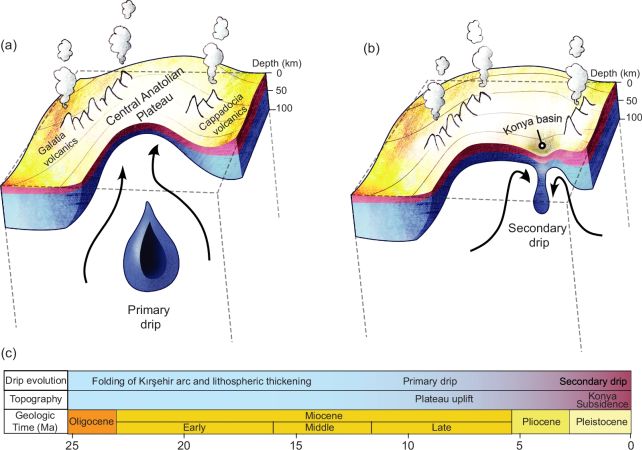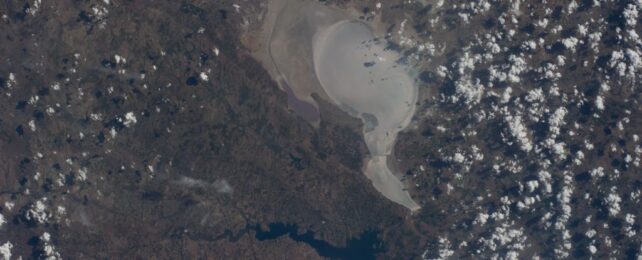Crinkles and divots in the surface of Earth on Türkiye's Central Anatolian Plateau are the smoking gun for a newly discovered class of plate tectonics.
Beneath a depression called the Konya Basin, Earth's crust is slowly dripping deeper into the planetary interior, a process that is gradually shaping the surface geology of not just the basin, but the plateau that surrounds it.
It's called lithospheric dripping, a phenomenon that has only recently been discovered here on Earth, and geologists are still figuring out the different ways it manifests.
"Looking at the satellite data, we observed a circular feature at the Konya Basin where the crust is subsiding or the basin is deepening," says geophysicist Julia Andersen of the University of Toronto.
"This prompted us to look at other geophysical data beneath the surface where we saw a seismic anomaly in the upper mantle and a thickened crust, telling us there is high-density material there and indicating a likely mantle lithospheric drip."

We have a pretty good idea of how it works. When the lower portion of Earth's rocky crust is heated to a certain temperature, it starts to go a little gooey. Then, like honey or syrup, it slowly oozes downward – a bit like a pitch drop experiment, but much bigger and slower.
As this drop descends, it pulls the planetary crust down with it. This creates a depression, or basin. Then, when the drop detaches into the mantle, the surface rebounds, bulging upwards, with a widespread effect.
We only began to understand this process a short time ago, but modeling its evolution has already allowed Andersen and her colleagues to identify one region of the mantle where dripping has taken place, at the Arizaro Basin under the Central Andes.
Now, careful analysis of surface geology and laboratory experiments has led them to another oozy drip under the Central Anatolian Plateau – and the signpost was the Konya Basin.
The Central Anatolian Plateau is known to be uplifting over time. Previous research suggests that it has gained around a kilometer (0.6 miles) in altitude over the past 10 million years thanks to the release of a crusty drip.
But then there's the Konya Basin, which is subsiding downwards at a rate of around 20 millimeters (0.8 inches) per year. That doesn't sound like much, but a sinking patch of ground in a region that is rising upwards warrants further investigation.
The team's findings suggest that the broader region of the plateau is in the throes of the rebound phase of the lithospheric drip process, after having dropped its gooey molten load into the mantle. The Konya Basin? That's a smaller, second drip forming.
"As the lithosphere thickened and dripped below the region, it formed a basin at the surface that later sprang up when the weight below broke off and sank into the deeper depths of the mantle," says Earth scientist Russell Pysklywec of the University of Toronto.
"We now see the process is not a one-time tectonic event and that the initial drip seems to have spawned subsequent daughter events elsewhere in the region, resulting in the curious rapid subsidence of the Konya Basin within the continuously rising plateau of Türkiye."

The researchers validated this model by setting up a lab experiment. They filled a plexiglass tank with a highly viscous silicone polymer called polydimethylsiloxane as a proxy for Earth's gooey lower mantle. A mixture of polydimethylsiloxane and modeling clay was used to replicate the upper mantle, while a mixture of ceramic spheres and silica sand served as the crust.
Then, they inserted a dense "seed" into the upper mantle layer to initiate a drip, and observed the results. Within 10 hours, the first drip had started to fall. By the time it reached the bottom of the box, after about 50 hours, a secondary drip had started to descend.
Neither drip was associated with horizontal deformation of the surface – only vertical. And these deformations were consistent with the Konya Basin.
"What we noticed was that over time, this secondary drip did pull the crust downward and started to create a basin, despite no horizontal movements in the crust at the surface," Andersen says. "The findings show these major tectonic events are linked, with one lithospheric drip potentially triggering a host of further activity deep in the planetary interior."
These results suggest that lithospheric dripping is a multi-stage process, and neatly explains the strange, simultaneous uplifting and subsidence observed on the Central Anatolian Plateau.
The research has been published in Nature Communications.
